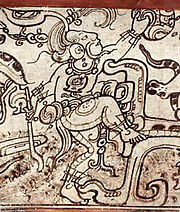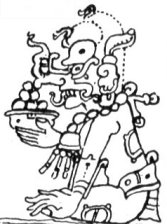Chaac
The Chorti Maya have preserved important folklore regarding the process of rain-making, which involved rain deities striking rain-carrying snakes with their axes.
In the traditional Maya (and Mesoamerican) community, one of the most important functions was that of rainmaker, which presupposed an intimate acquaintance with (and thus, initiation by) the rain deities, and a knowledge of their places and movements.
[citation needed] The ocellated turkey (yuum kuuts) is associated with the deity; one is yearly hunted and sacrificed to obtain its blood to be offered to fields in hopes of a good harvest.
A well-known myth in which the Chaacs (or related Rain and Lightning deities) have an important role to play is about the opening of the mountain in which the maize was hidden.
Versions of this myth[6] show the rain deity Chac in his war-like fury, pursuing the fleeing Sun and Moon, and attacking them with his lightning bolts.
[7] Classic period Maya sources also suggest that Chaac was the god who opened the mountain containing maize, using his lightning axe, K'awiil.
[8][9] Chaac is usually depicted with a human body showing reptilian or amphibian scales, and with a non-human head evincing fangs and a long, pendulous nose.
The king personifying the rain deity is then shown carrying war implements and making prisoners,[11] while his actions seem to be equated with the violence of a thunderstorm.
In 2024, a statue of the Greek god Poseidon located in Progreso, Yucatán, caused controversy for locals who deemed it offensive to their beliefs in Chaac.
[13] Activist lawyers sought to have the statue removed, and some people in Mexico cited Tropical Storm Alberto and Hurricane Beryl as proof that Chaac was upset at Poseidon.




